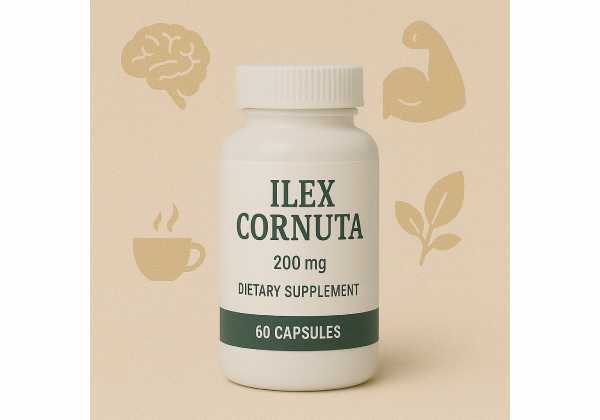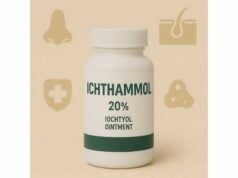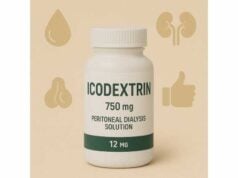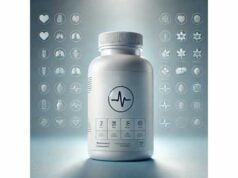
Ilex cornuta—better known as Chinese holly—is an evergreen shrub prized for glossy leaves and bright red berries. In traditional Chinese medicine (TCM), the dried leaves (often labeled as Ilicis Cornutae Folium) are used for “heat-clearing” formulas, and modern lab research explores antioxidant, anti-inflammatory, and liver-protective effects. At the same time, the vivid fruits are not food: holly berries contain saponins that can upset the stomach and should not be eaten. This article clarifies what Ilex cornuta can and cannot do, summarizes emerging evidence around metabolic and inflammatory pathways, and sets realistic expectations for safety and dosage. If you are curious whether Chinese holly belongs in your wellness routine—or if it is best left as a landscape plant—here you will find practical guidance grounded in research and traditional use, explained in plain language.
Quick Overview
- Preliminary evidence suggests leaf extracts support antioxidant and anti-inflammatory activity and may benefit liver fat and uric acid balance.
- Berries are not edible; ingestion can cause nausea, vomiting, and diarrhea.
- Research dose (animal): aqueous leaf extract 3 g/kg/day for 10 weeks; no established human dose.
- Avoid internal use during pregnancy, for young children, and for anyone with GI sensitivity or after berry ingestion.
Table of Contents
- What is Ilex cornuta?
- Does it work and what are the benefits?
- How to use it: forms and preparations
- Dosage and timing: what we know
- Safety, side effects, and who should avoid it
- Evidence at a glance: what the studies say
What is Ilex cornuta?
Ilex cornuta (Chinese holly) is a broadleaf evergreen native to East Asia. In gardens, it is grown for durable, spiny leaves and abundant red berries that persist through winter. The plant is dioecious, meaning male and female flowers grow on separate plants; many popular landscape cultivars set fruit readily and keep their berries into the colder months.
Beyond landscaping, the leaves of Ilex cornuta have a history of use in East Asian herbal practice. In TCM, the dried leaf—often listed as Ilicis Cornutae Folium—is incorporated into formulas aimed at clearing internal heat, soothing sore throat, and addressing certain skin or joint complaints. Although several Ilex species produce caffeinated beverages (e.g., yerba mate, Ilex paraguariensis; yaupon, Ilex vomitoria; guayusa, Ilex guayusa), Chinese holly is not a caffeine source and is not used like those “holly teas.” Its interest to modern researchers centers on non-caffeine compounds such as triterpenoid saponins and phenolics (for example, chlorogenic acid derivatives), which may influence inflammatory signaling and oxidative stress in cells and animal models.
A critical distinction: the attractive red berries are not a snack. Like other hollies, the fruits contain saponins and can cause gastrointestinal upset if eaten. Poison centers and horticulture references consistently advise keeping berries away from children and pets. Leaves and stems are typically not ingested raw; traditional use employs decoctions (simmered teas) or standardized extracts prepared by trained practitioners.
In short, Ilex cornuta is primarily an ornamental shrub with a traditional medicinal leaf. It is not a common dietary herb or beverage, and evidence for human health applications remains early-stage. Understanding what part of the plant is used, how it is prepared, and where the science stands will help you weigh potential benefits against practical and safety considerations.
Does it work and what are the benefits?
The strongest signals for Ilex cornuta’s potential come from laboratory and animal studies using leaf extracts. While these models cannot guarantee human benefit, they reveal plausible mechanisms:
Antioxidant and anti-inflammatory activity. Leaf extracts demonstrate the ability to quench reactive oxygen species and down-regulate pro-inflammatory pathways in cell culture. Researchers attribute this, in part, to triterpenoid saponins (unique structures frequently isolated from Ilex species) and polyphenols such as chlorogenic acid derivatives. In macrophage and cardiomyocyte models, specific saponin fractions from Ilex cornuta protected cells during oxidative stress, suggesting a general cytoprotective profile.
Liver-protective effects in diet-induced fat accumulation. In a controlled mouse experiment, an aqueous extract of Ilex cornuta leaves reduced hepatic fat and improved metabolic markers in animals fed a high-fat diet. Mechanistically, the extract modulated lipid metabolism pathways and dampened inflammatory signaling in liver tissue. While the model is preclinical, the findings align with the broader antioxidant/anti-inflammatory theme and offer a rationale for exploring metabolic health applications.
Uric acid balance and renal protection. Several groups have examined Ilex cornuta leaf extracts in hyperuricemia models. In rodent studies, extracts improved serum uric acid and influenced renal urate transporters, supporting more efficient uric acid handling. Investigators have also used integrated network-pharmacology and experimental validation to map potential targets and pathways (for example, xanthine oxidase activity and inflammatory mediators). These early results suggest a possible role for the herb in managing uric-acid–related metabolic stress, though clinical trials in people are still needed.
Traditional indications. Historical TCM descriptions emphasize “heat-clearing” and support for throat, skin, and joint discomforts—ideas that map loosely to modern concepts of inflammation and immune modulation. Contemporary pharmacology provides molecules and pathways that could underlie those traditional patterns, but translation to real-world outcomes requires human data.
What this means for you. If you are evaluating Ilex cornuta as a supplement, recognize the current evidence is promising but preliminary. Benefits most consistently observed in the lab—antioxidant defense, inflammation regulation, and metabolic support—have not yet been confirmed in high-quality human trials. That does not make the herb ineffective; it means dosing, indications, and long-term safety in people are not firmly established. For now, Ilex cornuta is best approached as a research-backed traditional ingredient, not as a first-line, stand-alone therapy for liver fat, gout, or cardiometabolic risk.
How to use it: forms and preparations
Because there is no standardized over-the-counter product profile for Chinese holly leaves, preparation varies. In traditional settings, the herb is rarely taken alone; it appears within multi-herb formulas, where practitioners balance actions and mitigate side effects. If you encounter Ilex cornuta in the marketplace, you will typically see one of these forms:
Aqueous extract (decoction). The classic preparation is a simmered tea. Dried leaves are gently boiled in water for 20–40 minutes and then strained. This method concentrates water-soluble polyphenols and saponins. In research, aqueous extracts are the most studied for metabolic endpoints (e.g., liver fat, uric acid handling). Home preparation should be conservative: use small amounts of dried leaf and avoid long courses without professional guidance, since human dosing has not been established.
Powdered extract capsules. Some specialty suppliers offer Ilex cornuta leaf extracts in capsule form. Potency can vary widely (e.g., leaf-to-extract ratios, solvent systems), and third-party testing is uncommon. If you choose a capsule product, look for transparent labeling, lot testing for contaminants (heavy metals, microbes), and clear identification of the plant part (“folium,” leaf) and species (Ilex cornuta).
Topical washes or soaks (traditional use). In some folk applications, a weak decoction is used externally for minor skin irritation. While this aligns with historical practice, robust clinical evaluation is lacking. If you try a topical preparation, patch-test first to rule out contact sensitivity.
What not to use. Do not consume the berries. They are attractive but can cause GI upset. Avoid raw leaves and stems. Do not substitute other hollies unless you know exactly what you are using; caffeinated Ilex species (mate/guayusa/yaupon) are not interchangeable with Chinese holly.
Combining with lifestyle changes. If your goal is metabolic support (e.g., non-alcoholic fatty liver patterns or elevated uric acid), focus on the foundations—nutrition quality, body-weight management, sleep, and activity. Herbal strategies can complement, but not replace, clinician-guided care and established therapies.
Sourcing and quality. Choose reputable sources that correctly identify the species (Ilex cornuta Lindl. & Paxton), the plant part (leaf), and provide batch information. Avoid ornamental hedge clippings; landscape plants may be treated with pesticides or grown near roads and are not suitable for ingestion.
Dosage and timing: what we know
There is no clinically established human dosage for Ilex cornuta leaf. Most of what we know comes from preclinical experiments that used extracts at specified concentrations:
- Animal research example: An aqueous leaf extract given to mice at 3 g/kg/day for 10 weeks reduced liver fat and modulated inflammatory and metabolic signaling. This is a high experimental dose relative to body mass and cannot be linearly applied to humans.
- Cell and tissue studies: Investigators often report extract concentrations in micrograms per milliliter to probe mechanisms (antioxidant capacity, inflammatory gene expression). These in-vitro concentrations don’t translate directly to practical human doses.
Because of the gap in human data, a prudent approach—if a trained herbal practitioner recommends Ilex cornuta—is to start with very low, food-like amounts and monitor tolerance. Practical guidelines:
- For teas/decoctions prepared by professionals: Begin with a weak decoction (for instance, a small handful of cut leaf simmered to yield one cup), once daily, for a short, supervised trial of 7–10 days while tracking symptoms and GI tolerance. This is not a standardized dose; it’s a cautious introduction that reflects the absence of validated human dosing.
- Avoid self-escalation. Do not scale up quantity or duration without expert oversight. The lack of human pharmacokinetic data means thresholds for benefit and side effects are unknown.
- Timing with meals. Taking a weak decoction with food may reduce the chance of stomach upset common to saponin-rich plants.
- Cycle and reassess. If used, consider intermittent courses (e.g., several days on, then pause) while you and your clinician assess whether it meaningfully supports your goals.
If you need a numeric anchor for the “dosage” box in your notes, use the research model figure (3 g/kg/day aqueous extract in mice) as a reference for how studies are designed—not as a human recommendation. Until clinical trials define safe and effective ranges in adults, it is more accurate to say “no established human dose.”
Safety, side effects, and who should avoid it
Berries are off-limits. Holly berries—including those of Ilex cornuta—contain saponins that can cause nausea, vomiting, diarrhea, abdominal pain, and dehydration if ingested. Keep them away from children and pets. If accidental ingestion occurs, seek poison-control guidance promptly.
Likely side effects from leaf preparations. Because the leaves also contain saponins and polyphenols, the most common adverse experiences reported with concentrated extracts are gastrointestinal: stomach discomfort, cramping, loose stools, or nausea—especially on an empty stomach or at higher strengths.
Allergy or sensitivity. Individuals with known sensitivity to hollies or to saponin-rich plants may react. Discontinue use if rash, itching, or persistent GI symptoms develop.
Drug interactions: theoretical. In the absence of human pharmacokinetics, it’s wise to consider theoretical interactions:
- Diuretics and uric-acid–active drugs (e.g., allopurinol, febuxostat, probenecid): extracts that influence uric acid transporters in animals could, in theory, nudge uric acid handling. Avoid unsupervised combination.
- Anticoagulants/antiplatelets: polyphenol-rich extracts sometimes alter platelet activity in vitro; clinical relevance is unknown. Use caution if you take warfarin, direct oral anticoagulants, or daily aspirin.
- Blood pressure or lipid medications: since rodent work explores metabolic and cardiovascular pathways, coordinate with your clinician to prevent duplicative or conflicting effects.
Who should avoid internal use unless advised by a clinician trained in herbal medicine:
- Pregnant or breastfeeding individuals.
- Children and adolescents.
- People with a history of significant GI disease (e.g., inflammatory bowel disease, peptic ulcer) or who are very sensitive to bitter or saponin-rich herbs.
- Those with kidney disease or recurrent kidney stones, especially if exploring Ilex cornuta for uric-acid–related concerns—medical supervision is essential.
Topical use. A dilute decoction used externally is lower risk but still warrants a patch test to rule out irritation.
Quality and contamination. As with any herb, choose products tested for heavy metals, microbes, and pesticide residues. Do not ingest ornamental plant material.
When to stop and seek care. Discontinue and consult a professional if you experience persistent vomiting or diarrhea, severe abdominal pain, signs of an allergic reaction, unusual bruising/bleeding, or if you are taking multiple prescription medications and notice unexpected changes (blood pressure, bleeding, swelling, or lab abnormalities).
Bottom line: Ilex cornuta can be handled safely with common-sense precautions—but berries are not safe to eat, and internal use of concentrated leaf preparations belongs under professional guidance until human dosing and interaction data are clearer.
Evidence at a glance: what the studies say
What is most studied? The leaf. Researchers isolate triterpenoid saponins (unique ring-structured molecules) and profile polyphenols. These compounds are tested in cells and animal models relevant to cardiometabolic stress, oxidative injury, and inflammation.
Models and outcomes:
- High-fat diet mouse model: Aqueous leaf extract administered daily reduced liver fat accumulation, improved markers of hepatic inflammation, and favorably shifted lipid metabolism genes. This suggests potential hepatoprotective and metabolic benefits worth testing in people predisposed to non-alcoholic fatty liver patterns.
- Hyperuricemia models: Leaf extracts lowered serum uric acid in rodents and modulated renal urate transporters, aligning with a potential role in gout-related physiology. Network-pharmacology studies further mapped plausible targets (e.g., xanthine oxidase, inflammatory mediators), then confirmed effects in vivo.
- Anti-inflammatory and cardioprotection assays: In cell lines, specific Ilex cornuta saponins shielded cardiomyocytes from oxidative injury and decreased inflammatory signaling in macrophage models—mechanistic support for traditional “heat-clearing” indications.
What is less studied? Rigorous human clinical trials. To date, there are no large, randomized, placebo-controlled studies testing Ilex cornuta leaf as a single-agent intervention in people. Dosing, bioavailability, and long-term safety remain uncertain.
How does it compare to other hollies? Unlike yerba mate, yaupon, or guayusa, Chinese holly is not a caffeine source and is not consumed as a daily stimulant beverage. Its research niche is saponins and polyphenols, not methylxanthines. That makes it potentially complementary rather than interchangeable with caffeinated holly species.
Practical takeaway. The evidence base is promising but preliminary, with consistent signals across independent labs for antioxidant, anti-inflammatory, and metabolic pathways—mainly in animals and cells. This justifies careful, practitioner-guided exploration for specific goals (e.g., uric acid balance) while we wait for human trials to define who benefits, at what dose, and with what long-term risk profile.
References
- Preventive Effects of Ilex Cornuta Aqueous Extract on High-Fat Diet-Induced Fatty Liver of Mice and Its Mechanisms 2022 (Animal Study)
- Ilex cornuta leaves extracts ameliorate hyperuricemia by modulating uric acid transporters 2025 (Animal/In Vitro)
- In Vitro Anti-Inflammatory Activity of Ilex cornuta Extract on RAW 264.7 Cells 2017 (In Vitro)
- Ilex cornuta (Chinese Holly, Horned Holly) 2024 (Safety Reference)
- Holly Berries: A Beautiful Decoration But a Poisonous Snack 2023 (Poison Control Guidance)
Disclaimer
This article is for informational purposes only and does not substitute for professional medical advice, diagnosis, or treatment. Do not ingest holly berries. Internal use of Ilex cornuta leaf or extracts should be guided by a qualified healthcare professional, especially if you are pregnant or breastfeeding, have medical conditions, or take prescription medications. If you think you have been poisoned or have ingested holly berries, contact your local poison control center immediately.
If you found this guide helpful, please consider sharing it on Facebook, X (formerly Twitter), or your favorite platform, and follow us for future evidence-based updates. Your support helps us continue producing high-quality, people-first health content.










